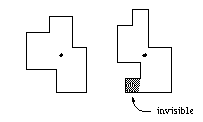标签:des blog class code tar ext
| Time Limit: 1000MS | Memory Limit: 10000K | |
| Total Submissions: 3145 | Accepted: 1391 |
Description

Input
Output
Sample Input
4 0 0 0 1 1 1 1 0 8 0 0 0 2 1 2 1 1 2 1 2 2 3 2 3 0 0
Sample Output
Floor #1 Surveillance is possible. Floor #2 Surveillance is impossible.
给定一个多边形,求多边形的核。
将多边形每一条边延长,然后计算半平面交。
判断点与直线关系由于模板少了一个等于号,导致当半平面退化成单点的时候判断出错,虽然浪费了一天的时间,但是改正了模板的一个错误,
还是值得的。
代码:
/* ***********************************************
Author :_rabbit
Created Time :2014/5/4 15:03:55
File Name :20.cpp
************************************************ */
#pragma comment(linker, "/STACK:102400000,102400000")
#include <stdio.h>
#include <iostream>
#include <algorithm>
#include <sstream>
#include <stdlib.h>
#include <string.h>
#include <limits.h>
#include <string>
#include <time.h>
#include <math.h>
#include <queue>
#include <stack>
#include <set>
#include <map>
using namespace std;
#define INF 10000000
#define eps 1e-8
#define pi acos(-1.0)
typedef long long ll;
int dcmp(double x){
if(fabs(x)<eps)return 0;
return x>0?1:-1;
}
struct Point{
double x,y;
Point(double _x=0,double _y=0){
x=_x;y=_y;
}
};
Point operator + (const Point &a,const Point &b){
return Point(a.x+b.x,a.y+b.y);
}
Point operator - (const Point &a,const Point &b){
return Point(a.x-b.x,a.y-b.y);
}
Point operator * (const Point &a,const double &p){
return Point(a.x*p,a.y*p);
}
Point operator / (const Point &a,const double &p){
return Point(a.x/p,a.y/p);
}
bool operator < (const Point &a,const Point &b){
return a.x<b.x||(a.x==b.x&&a.y<b.y);
}
bool operator == (const Point &a,const Point &b){
return dcmp(a.x-b.x)==0&&dcmp(a.y-b.y)==0;
}
double Dot(Point a,Point b){
return a.x*b.x+a.y*b.y;
}
double Length(Point a){
return sqrt(Dot(a,a));
}
double Angle(Point a,Point b){
return acos(Dot(a,b)/Length(a)/Length(b));
}
double angle(Point a){
return atan2(a.y,a.x);
}
double Cross(Point a,Point b){
return a.x*b.y-a.y*b.x;
}
Point vecunit(Point a){
return a/Length(a);
}
Point Normal(Point a){
return Point(-a.y,a.x)/Length(a);
}
Point Rotate(Point a,double rad){
return Point(a.x*cos(rad)-a.y*sin(rad),a.x*sin(rad)+a.y*cos(rad));
}
double Area2(Point a,Point b,Point c){
return Length(Cross(b-a,c-a));
}
struct Line{
Point p,v;
double ang;
Line(){};
Line(Point p,Point v):p(p),v(v){
ang=atan2(v.y,v.x);
}
bool operator < (const Line &L) const {
return ang<L.ang;
}
};
bool OnLeft(const Line &L,const Point &p){
return dcmp(Cross(L.v,p-L.p))>=0;
}
Point GetLineIntersection(Point p,Point v,Point q,Point w){
Point u=p-q;
double t=Cross(w,u)/Cross(v,w);
return p+v*t;
}
Point GetLineIntersection(Line a,Line b){
return GetLineIntersection(a.p,a.v,b.p,b.v);
}
vector<Point> HPI(vector<Line> L){
int n=L.size();
sort(L.begin(),L.end());//将所有半平面按照极角排序。
/*for(int i=0;i<n;i++){
cout<<"han "<<i<<" ";
printf("%.2lf %.2lf %.2lf %.2lf %.2lf\n",L[i].p.x,L[i].p.y,L[i].v.x,L[i].v.y,L[i].ang);
}*/
int first,last;
vector<Point> p(n);
vector<Line> q(n);
vector<Point> ans;
q[first=last=0]=L[0];
for(int i=1;i<n;i++){
while(first<last&&!OnLeft(L[i],p[last-1]))last--;//删除顶部的半平面
while(first<last&&!OnLeft(L[i],p[first]))first++;//删除底部的半平面
q[++last]=L[i];//将当前的半平面假如双端队列顶部。
if(fabs(Cross(q[last].v,q[last-1].v))<eps){//对于极角相同的,选择性保留一个。
last--;
if(OnLeft(q[last],L[i].p))q[last]=L[i];
}
if(first<last)p[last-1]=GetLineIntersection(q[last-1],q[last]);//计算队列顶部半平面交点。
}
while(first<last&&!OnLeft(q[first],p[last-1]))last--;//删除队列顶部的无用半平面。
if(last-first<=1)return ans;//半平面退化
p[last]=GetLineIntersection(q[last],q[first]);//计算队列顶部与首部的交点。
for(int i=first;i<=last;i++)ans.push_back(p[i]);//将队列中的点复制。
return ans;
}
double PolyArea(vector<Point> p){
int n=p.size();
double ans=0;
for(int i=1;i<n-1;i++)
ans+=Cross(p[i]-p[0],p[i+1]-p[0]);
return fabs(ans)/2;
}
Point pp[200];
int main()
{
//freopen("data.in","r",stdin);
//freopen("data.out","w",stdout);
int n;
int cc=0;
while(~scanf("%d",&n)&&n){
for(int i=0;i<n;i++)scanf("%lf%lf",&pp[i].x,&pp[i].y);pp[n]=pp[0];
Point a,b;
vector<Line> L;
Line s;
a=Point(-INF,-INF);b=Point(INF,-INF);s=Line(a,b-a);L.push_back(s);
a=Point(INF,-INF);b=Point(INF,INF);s=Line(a,b-a);L.push_back(s);
a=Point(INF,INF);b=Point(-INF,INF);s=Line(a,b-a);L.push_back(s);
a=Point(-INF,INF);b=Point(-INF,-INF);s=Line(a,b-a);L.push_back(s);
for(int i=0;i<n;i++){
L.push_back(Line(pp[i],pp[i]-pp[i+1]));
}
vector<Point> ans=HPI(L);
if (cc) cout << endl;cout << "Floor #" << ++cc << endl;
if (!ans.size()) cout << "Surveillance is impossible.\n";
else cout << "Surveillance is possible.\n";
}
return 0;
}
POJ 1474 多边形的核(半平面交),布布扣,bubuko.com
标签:des blog class code tar ext
原文地址:http://blog.csdn.net/xianxingwuguan1/article/details/25081847